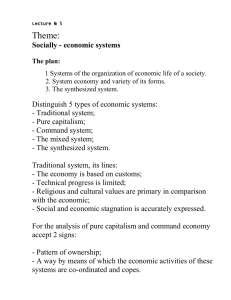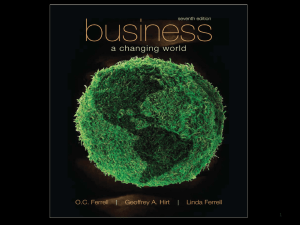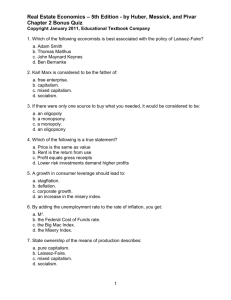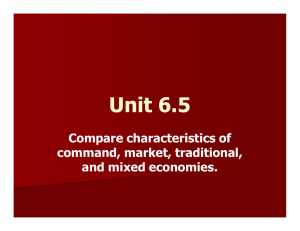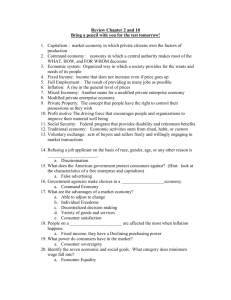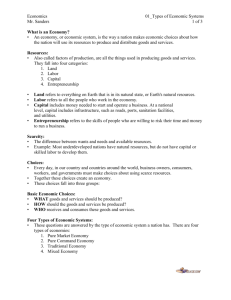Quiz for Chapter 2
advertisement
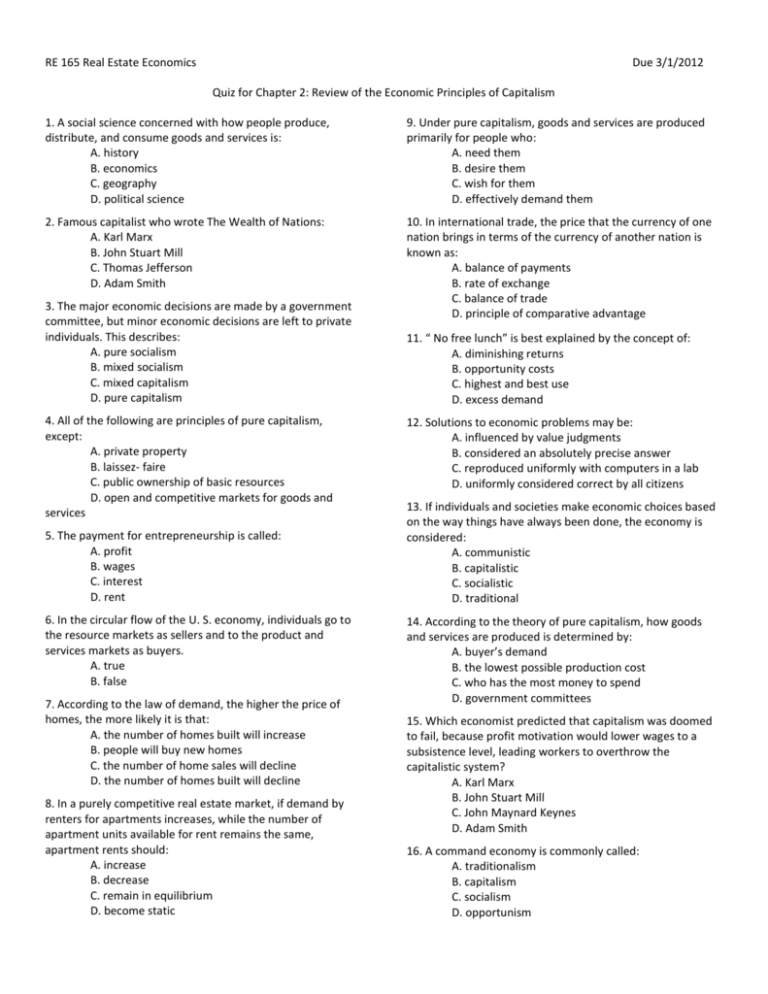
RE 165 Real Estate Economics Due 3/1/2012 Quiz for Chapter 2: Review of the Economic Principles of Capitalism 1. A social science concerned with how people produce, distribute, and consume goods and services is: A. history B. economics C. geography D. political science 9. Under pure capitalism, goods and services are produced primarily for people who: A. need them B. desire them C. wish for them D. effectively demand them 2. Famous capitalist who wrote The Wealth of Nations: A. Karl Marx B. John Stuart Mill C. Thomas Jefferson D. Adam Smith 10. In international trade, the price that the currency of one nation brings in terms of the currency of another nation is known as: A. balance of payments B. rate of exchange C. balance of trade D. principle of comparative advantage 3. The major economic decisions are made by a government committee, but minor economic decisions are left to private individuals. This describes: A. pure socialism B. mixed socialism C. mixed capitalism D. pure capitalism 4. All of the following are principles of pure capitalism, except: A. private property B. laissez- faire C. public ownership of basic resources D. open and competitive markets for goods and services 5. The payment for entrepreneurship is called: A. profit B. wages C. interest D. rent 6. In the circular flow of the U. S. economy, individuals go to the resource markets as sellers and to the product and services markets as buyers. A. true B. false 7. According to the law of demand, the higher the price of homes, the more likely it is that: A. the number of homes built will increase B. people will buy new homes C. the number of home sales will decline D. the number of homes built will decline 8. In a purely competitive real estate market, if demand by renters for apartments increases, while the number of apartment units available for rent remains the same, apartment rents should: A. increase B. decrease C. remain in equilibrium D. become static 11. “ No free lunch” is best explained by the concept of: A. diminishing returns B. opportunity costs C. highest and best use D. excess demand 12. Solutions to economic problems may be: A. influenced by value judgments B. considered an absolutely precise answer C. reproduced uniformly with computers in a lab D. uniformly considered correct by all citizens 13. If individuals and societies make economic choices based on the way things have always been done, the economy is considered: A. communistic B. capitalistic C. socialistic D. traditional 14. According to the theory of pure capitalism, how goods and services are produced is determined by: A. buyer’s demand B. the lowest possible production cost C. who has the most money to spend D. government committees 15. Which economist predicted that capitalism was doomed to fail, because profit motivation would lower wages to a subsistence level, leading workers to overthrow the capitalistic system? A. Karl Marx B. John Stuart Mill C. John Maynard Keynes D. Adam Smith 16. A command economy is commonly called: A. traditionalism B. capitalism C. socialism D. opportunism 17. Regarding the circular flow of the economy, which of the following is true? A. Individuals and households sell goods and services and receive income. B. Business supplies resources and receives wages. C. The product market is where the factors of production are exchanged. D. In the resource market, land, labor, capital, and business skills are exchanged for income. 18. A place in which buyers and sellers meet to bargain and exchange items of value at negotiated prices is called: A. a market B. an economy C. gross domestic product D. derived demand 19. A change or shift in supply is caused by a change in: A. the cost of the factors of production B. population C. consumer tastes D. the amount of advertising 20. In a given real estate market, if the demand for commercial office space declines and the supply of office space also declines at the same ratio, market rent per square foot should: A. increase B. decrease C. remain the same D. shift to the right 21. That point at which supply and demand are matched at a price that will clear the market is called: A. open B. equilibrium C. comparative advantage D. surplus 22. The total quantity that buyers are willing to buy at a given time at certain prices is called: A. supply B. demand C. equilibrium D. perfect competition 23. A summary of all transactions between the citizens of one nation and the citizens of all other countries is called: A. free trade B. rate of exchange C. balance of trade D. balance of payments 24. In the short run, the lower the value of the U. S. dollar versus the Japanese yen, the: A. more attractive American products are to the Japanese B. less likely Japanese investors will buy U. S. real estate C. more likely U. S. citizens will purchase Japanese products D. more likely the price of U. S. exports will rise in the Japanese market 25. Economic theory states that the United States can become self-sufficient, with no need for international trade, if the United States is willing to: A. drive up the price of domestic consumer goods and services B. limit the economic choices of U. S. citizens C. cancel all trade agreements D. do all of the above


